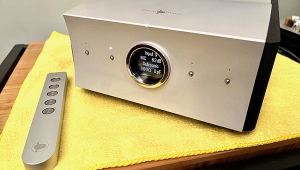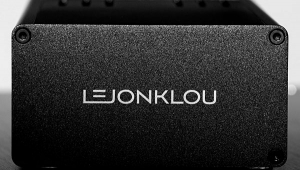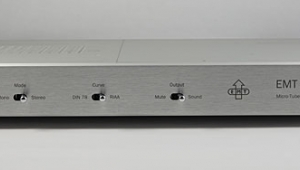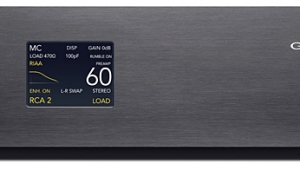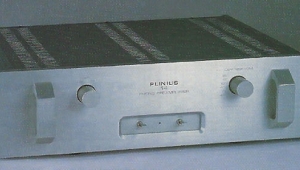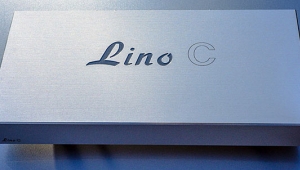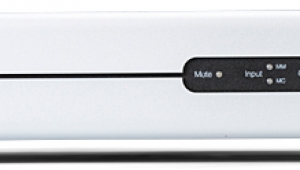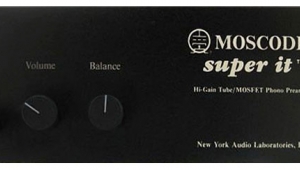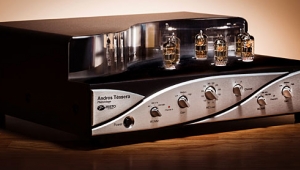| Columns Retired Columns & Blogs |
Boulder 2008 phono preamplifier & 2010 preamplifier Measurements
Sidebar 3: Measurements
Beginning with the Boulder 2008 phono preamplifier, I set the parameters for one of its inputs to MM/High Impedance for most of the tests, to be sure that the 50 ohm balanced source impedance of my Audio Precision System One would not interfere with the accuracy of the readings. In this condition the 2008's input impedance at 1kHz was 44.7k ohms. With it set to MC/Low Impedance, with no resistors added, the input impedance was 1335 ohms, again at 1kHz.
The MM gain was slightly lower than usual, at 34.2dB (1kHz). The MC gain was higher, of course, at 63.7dB, and the 2008 appeared to preserve absolute polarity (pin 2 of the XLRs is wired as hot). The 2008's output impedance was a low 100 ohms across the audioband.
Fig.1 shows the 2008's RIAA error, plotted up to the 100kHz limit of the AP pre-emphasis file. The response is superbly flat, with just a fraction of a dB droop evident at the very highest frequency. The pair of traces in fig.1 are repeated as the top traces in fig.2, which shows the 2008's frequency response plotted with the high-pass filter set to 20Hz, 10Hz, and 5Hz, and switched out of circuit. As I expected, each filter's label corresponds to its -3dB point. What I didn't expect was the 0.35dB insertion loss when the filter was in-circuit, and that the 10Hz and 20Hz positions resulted in a response that rose slightly above the audioband.

Fig.1 Boulder 2008, RIAA error (0.5dB/vertical div.).

Fig.2 Boulder 2008, frequency response with (from top to bottom at 100Hz): no high-pass filter; filter set to "5Hz," "10Hz," "20Hz" (1dB/vertical div.).
Channel separation (not shown) was excellent, at better than 90dB in the midrange, worsening slightly to 78dB at 20kHz. The signal/noise ratio was lower than I expected, at 46dB (MM ref. 5mV input at 1kHz) and 36dB (MC ref. 0.5mV input at 1kHz). These are wideband figures; switching an A-weighting filter in-circuit resulted in a significant improvement, to 58dB and 49dB, respectively. Looking at the residual noise waveform on an oscilloscope screen confirmed that it is mainly very-low-frequency noise, which will be rejected by the A-weighting filter.
This LF noise can be seen at the left side of fig.3, which shows the spectrum of a 1kHz tone at the extraordinarily high input level of 200mV. I had run this test of the MM input at such a high level (32dB above the reference level of 5mV) to try to find distortion harmonics—I hadn't found any distortion above the noise floor at more reasonable levels. Even so, the only harmonic to poke its head above -100dB was the seventh. At -94dB (0.002%), however, this will be innocuous.

Fig.3 Boulder 2008, spectrum of 1kHz sinewave, DC-24kHz, at 200mV MM input (linear frequency scale).
As a result of the Boulder circuit's extraordinary linearity and dynamic range, the MM overload margins were the highest I have ever measured: 42.1dB at 20Hz, 41.5dB at 1kHz, and 41.1dB at 20kHz, each equivalent to an output of 30.5V! Partly, this superb performance will be due to the lower-than-usual MM gain. But even when the module was set to MC, the margins were still superbly high, at 32.9dB, 32.0dB, and 31.8dB, respectively, and again equivalent to an output voltage of 30.5V.
As set for Michael Fremer's review, the Boulder 2010 control preamplifier had a maximum gain of 10.07dB. The input impedance was very high, at a measured 310k ohms at 1kHz, which means that it will hardly load source components at all. Absolute polarity was preserved with the XLRs wired with pin 2 hot and the front-panel switch set to Normal. Like the 2008, the 2010's output impedance was a low 100 ohms across the band.
The frequency response at a 1V output level and with the volume control set to "0" is shown in fig.4: absolutely flat in the audioband, and rolling off to -1.5dB at the 200kHz upper limit of this measurement. Repeating the measurement with the volume control set to "-20dB," and the input level raised by 20dB to give the same 1V output level, reduced the ultrasonic rolloff slightly but insignificantly to -1.25dB at 200kHz.

Fig.4 Boulder 2010, frequency response at 1V into 100k ohms (0.5dB/vertical div.).
Given the 2010's dual-mono construction, I was expecting to find superb channel separation. To my surprise, and as shown in fig.5, there was evidence of capacitive coupling between the channels (the 6dB/octave positive slope to the traces above 1kHz). The R-L bleedthrough was buried in the noise below that frequency, but—again to my surprise—the measured channel separation decreased at low frequencies in the other direction.

Fig.5 Boulder 2010, channel separation (R-L dashed, 10dB/vertical div.).
Like the 2008, the 2010's circuit is superbly linear. Fig.6 shows the measured THD+noise percentage plotted against frequency at 1V output into both 100k ohms and 600 ohms. The distortion is actually lower in level into the lower impedance, though it does rise slightly at high frequencies. At no time, however, does it rise to a level that could be considered significant.

Fig.6 Boulder 2010, THD+noise vs frequency at (from top to bottom at 1kHz): 1V into 100k ohms, 1V into 600 ohms.
This can also be seen in fig.7, which shows the spectrum of a 50Hz sinewave driven at an extraordinarily high 10V into 600 ohms. Yes, some second harmonic can be seen at -103dB (0.0007%), as well as some higher harmonics around -100dB, but these are probably either mathematical artifacts of the FFT or residuals in the Audio Precision's output. The picture was similar when I examined high-frequency intermodulation, again at the very high level of 10V, which was just below clipping with this signal into the low, 600 ohm load: all you can really see in fig.8 is the distortion present in the output of the D/A processor used.

Fig.7 Boulder 2010, spectrum of 50Hz sinewave, DC-1kHz, at 10V into 600 ohms (linear frequency scale).

Fig.8 Boulder 2010, HF intermodulation spectrum, DC-24kHz, 19+20kHz at 10V into 600 ohms (linear frequency scale).
Finally, fig.9 plots the percentage of THD+noise present in the 2010's output against output voltage. Below 10V or so, the reading is dominated by what noise is present, and the actual distortion is at the limit of the Audio Precision's resolution, which is why there are some sawteeth present in the traces, due to the AP's gain switching. The actual clip points occur at 25V into 100k ohms and 21V into 600 ohms, both about 20dB above the typical maximum output voltage the 2010 will be called upon to deliver under real-world conditions.

Fig.9 Boulder 2010, distortion (%) vs output voltage into 100k ohms (bottom and right) and 600 ohms (top and left).
Both of these Boulder preamplifiers have overall measured performance that reveals superb audio engineering skill on the part of their designer. In addition, as Michael Fremer mentions in his review, when I auditioned the 2008 and 2010 in his system, I was bowled over by the sound quality they produced with his Nu-Vista amplifier driving the Rockport speakers.—John Atkinson
- Log in or register to post comments
